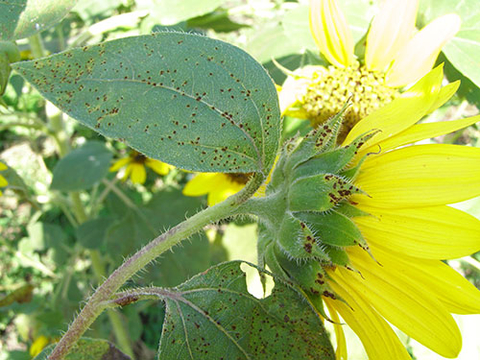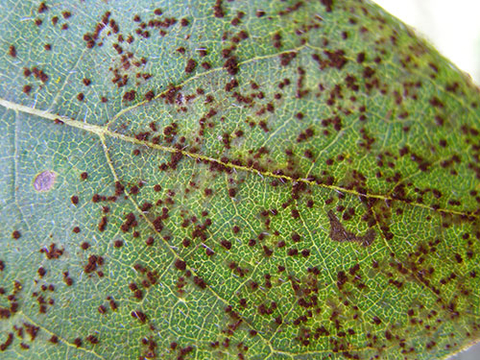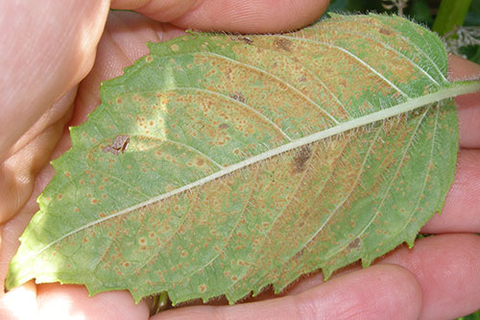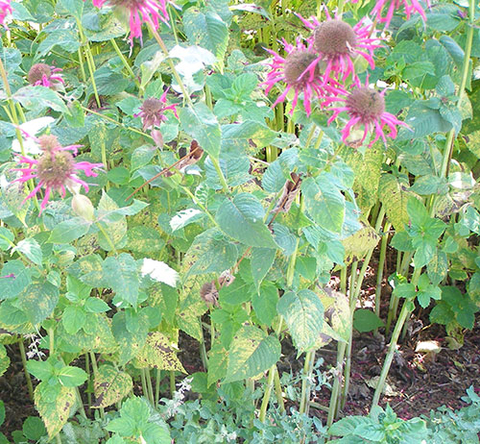Quick facts
- Before buying plants, look closely at the inner and lower leaves.
- Don’t buy plants that have yellow, orange or red spots.
- Look for rust resistant varieties in seed catalogs, on seed packages, and on plant labels.
- A little spotting on the leaves will not significantly affect the health and growth of the plant.
- Pinch off rust infected leaves and remove them from the garden.
- Do not remove more than 1/3 of the plant’s leaves at any one time.
- Rust is caused by a fungus that needs water on the surface of leaves to start growing, so reduce moisture on plant leaves by watering at the base of the plant.
Rust is a common fungal disease of many different plants in the flower garden. The bright red, orange, yellow, and brown colors of this disease often draw attention and can detract from a plant’s appearance.
The disease rarely does significant damage to the health of the plant. On rare occasions, a highly susceptible plant may suffer severe damage due to rust. These plants should be replaced with less susceptible plants.
Managing rust in the flower garden
Plant resistant varieties
- Rust resistant plants are only available for some perennial and annual flowers.
- Look for rust resistant varieties in seed catalogs, on seed packages, and on plant labels.
- Russian hollyhock (Alcea rugosa) and Figleaf hollyhock (Alcea ficifolia) are more resistant to hollyhock rust than common hollyhock (Alcea rosea).
- Ivy geranium (Pelargonium peltatum) is more resistant to geranium rust than the more common florist's geranium (Pelargonium x hortorum).
- Some rust resistant varieties of snapdragon and daylilies are available.
- A widely used resistant variety can ‘lose’ its resistance as the population of rust fungi changes to overcome this resistance. If a resistant variety becomes infected with rust, switch to a different variety.
Prevent rust from starting or spreading
- Inspect all plants prior to purchase. Look closely at the inner and lower leaves where humidity is high. Reject any plants that have yellow, orange, or red spots.
- Tolerate low levels of rust in the flower garden. Some spotting on the leaves will not significantly affect the health and growth of the plant.
- Inspect plants regularly. Examine the inner and lower leaves where humidity is high.
- Pinch off rust infected leaves and remove them from the garden. Do not remove more than 1/3 of the plant’s foliage at any one time.
- At the end of the growing season, cut infected plants at the soil line and remove all plant debris from the garden.
- Severely infected plants should be removed and replaced with a resistant variety or a plant from a different family.
- Infected leaves, stems, or plants should be buried in a compost pile that heats up to 148° F or taken to a municipal compost facility.
- Reduce moisture on plant leaves.
- Space plants to allow air movement between plants.
- Thin or divide overgrown perennials.
- Use drip irrigation or soaker hose to apply water to the soil, not the leaves.
- If sprinkler irrigation is the only option, water early in the day on a sunny day so leaves dry quickly.
- Water until the soil is moist to a depth of 6 to 9 inches. Do not water again until the top 3 to 6 inches of soil are dry.
- Mulch the soil around plants with a 2 to 3 inch even layer of woodchips or other organic mulch.
Using pesticides
Fungicides are rarely necessary to manage rust in a home garden and should only be used to protect high-value plants that cannot be replaced and have a history of severe infection.
- Fungicides must be applied to healthy green tissue early in the growing season before infection begins.
- Examine the lower leaves of plants with history of severe rust once a week. When the first leaf spot is observed, pinch off the infected leaves and begin fungicide sprays to protect healthy tissues.
- Repeat applications are often necessary throughout the growing season and should be applied according to label instructions.
- Fungicides will not cure or remove existing rust infections. Once the majority of leaves have leaf spots, it is too late to treat.
- Fungicides with the active ingredient Myclobutanil or Azoxystrobin are most effective against rust fungi.
- Fungicides with the active ingredient Chlorothalonil or Thiophanate methyl provide some protection against rust fungi but not complete protection.
CAUTION: Mention of a pesticide or use of a pesticide label is for educational purposes only. Always follow the pesticide label directions attached to the pesticide container you are using. Be sure that the area you wish to treat is listed on the label of the pesticide you intend to use. Remember, the label is the law.
How to know if you have rust on your plants
- Yellow, orange, or red spots on leaves.
- Raised pustules of powdery spores form on the lower leaf surface just below leaf spots. Pustules can occur on all green parts of the plant including stems, petioles, and the flower calyx.
- Spores can be yellow, orange, or brown and can easily be seen as a colorful powder on hands or on a white tissue that has been gently rubbed on the leaf.
- Some rusts produce tiny cup-shaped spore producing structures on infected leaves.
- Dark brown to black lines and dots may form around the edges or within leaf spots at the end of the growing season. These are hard survival spores produced by the rust fungi.
- Severely infected leaves may turn yellow or brown or fall off.
- Severely infected plants may be stunted, discolored, and wilt easily.
- Rust is caused by a group of related fungi in the order Uredinales.
- Rust fungi have complicated lifecycles that include five different types of spores and sometimes two completely different host plants.
- Rust fungi can only survive by feeding off of live plant tissue. Rust fungi do not intentionally kill a plant, but infected plants may have reduced vigor due to the rust fungi’s ability to divert plant resources for its own needs.
- Spores of rust fungi are easily spread by the wind and occasionally splashing water. They need a film of water on the foliage from rain, dew, or irrigation to germinate and start a new infection.
- Rust fungi can be introduced to the garden on infected plants or as windblown spores from nearby infected plants.
- Weeds from the same family as the garden plant can become infected and serve as a location for the rust fungi to survive and reproduce.
- At the end of the growing season, rust fungi can produce a thick-walled resting spore that allows it to survive through the winter. These are formed on the edges or within leaf spots or stem infections and persist from one season to the next in plant debris.
- Some rust fungi survive by infecting perennial plant parts like branches or crowns.
Many commonly grown annual and perennial flowering plants, as well as ornamental grasses, can be infected by rust fungi.
Each species of rust fungi is only able to infect a limited group of plants. Some infect only one species of plant. Others are able to infect several plants within the same family.
Some rust fungi have an ‘alternate host’. These rust fungi spend half of their life on one group of plants and the other half of their life on a completely different group of plants. A common example is cedar apple rust, which spends half of its lifecycle infecting Junipers (Juniperus spp.) and the other half infecting apple or crabapple trees (Malus spp.).
Other rust fungi have no alternate host and their entire life cycle occurs on one plant or plant family. Hollyhock rust infects only hollyhocks and weeds in Malvaceae, the hollyhock family.
Reviewed in 2024






